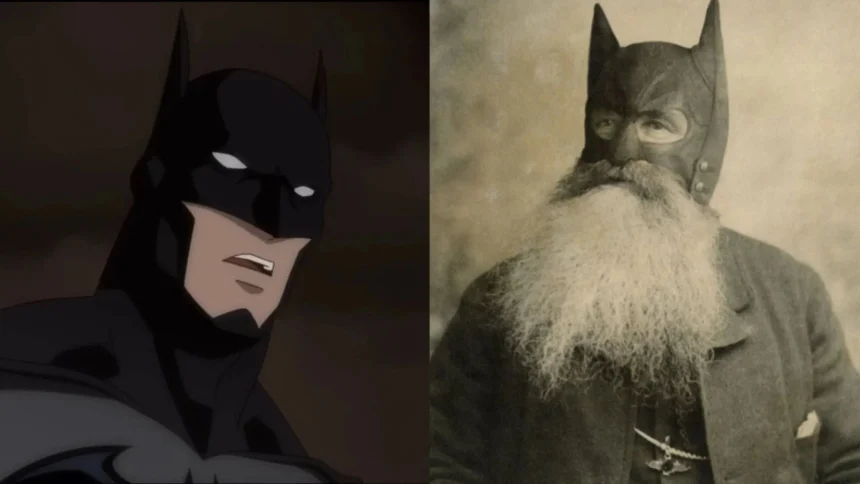Wayne Bruce Scotland batman is often cited in shared posts on various social platforms as the vigilante from which Batman got his inspiration from.
Supposed to be a relative to Robert the Bruce, a man who waged war against the criminals in the 1880s in Glasgow to inspire the development of Gotham City.
Nevertheless, this concept is considered a myth since no strong link can be established between Wayne Bruce Scotland Batman as an origin.
Batman was co created by Bob Kane and Bill Finger, The character was influenced by many different references such as winged glove and the name Bruce Wayne from Robert the Bruce.
The Viral Photo Explained
The spread of a bearded man wearing a bat mask with Batman is attributed to Wayne Bruce Scotland Batman got popular on social media as a result of Jake Shearer post that he was a Scottish superhero who inspired Batman.
This photo bounced around which generates humorous stories of Batman’s actual modus operandi.
However, reverse image searches reveal they are a doctored photo, a piece called “Batbarbone” created in 2012 that has no relation to Batman whatsoever.
The Origins of Batman
Batman’s origin is one of the most popular, which was created by Bob Kane with help of Bill Finger where the story reveals Bruce Wayne, a young boy, witnessing the death of his parents, Thomas and Martha Wayne at the hands of a small-time criminal Joe Chill.
This incident makes Bruce dedicate his existence to fighting crime and bringing justice to their demise.
The Scottish Influence on Batman’s Creation
Robert the Bruce is one of the leading historical personalities of Scotland; he was the King of Scotland during this first war of Scottish independence and the victor of Bannockburn in 1314.
He left behind the Declaration of Arbroath which declared Scotland’s independence.
Originally, the connection between Robert the Bruce and “Bruce Wayne” is their last names; Batman, whose real name is Bruce Wayne, stands for power and fight against tyranny which corresponds to the fight of Bruce for Scotland’s liberty.
Fact-Checking Wayne Bruce’s Story
Some narratives have suggested that a colonial figure known as Wayne Bruce Scotland batman was a vigilante, but most such stories are mere myths, and there is little exceptional evidence of such a figure’s existence.
It’s interesting that some of the narratives suggest that he was doing so a few decades before 1900, but there is no evidence to support this statement. On the other hand, Batman’s real identity Bruce Wayne has a well-developed origin narrative by Bob Kane and Bill Finger due to the parent’s shooting death.
This difference indicates that Wayne Bruce Scotland Batman wants fans to accept the story as a myth carved from futuristic lore and bearing no relations with history, while Bruce Wayne is one of the oldest characters in the comic book domains, exploring trauma and justice motifs.
Bill Smith vs. Wayne Bruce
Another person referred to as inspiring Bruce Wayne and thus Batman is Bill Smith, found in comix Legends of Batman issue 2 a butcher who turned into a vigilante, fighting crime in the streets of New York of the end of the nineteenth century wearing a bat mask.
However, similar to the tale of Wayne Bruce Scotland batman, the assertions made over Bill Smith lack evidence as well as historiography backing.
Both have been common on social media, but questions that claim most of them as fake or attributed to the wrong actor have debunked them.
Reverse Image Search Findings
Reverse image searches show that the viral photo associated with Wayne Bruce is incorrectly attributed; it is a digitally created image called “Batbarbone” from 2012, with no genuine ties to Batman or historical figures.
The image has circulated widely without accurate context, resulting in misunderstandings about its origins.
This highlights how easily images can be altered online, contributing to contemporary myths about popular culture icons like Batman.
Social Media’s Role in Spreading Legends
Social media significantly contributes to the spread of myths, such as the one about Wayne Bruce Scotland Batman, by creating an environment conducive to misinformation.
Users frequently share content without confirming its accuracy, resulting in the broad distribution of false information.
Research indicates that a small percentage of active users are responsible for the majority of fake news sharing, suggesting that platform design, rather than individual naivety, is the main factor behind this issue.
Furthermore, false news circulates more rapidly than true stories because of its novelty and emotional impact, underscoring the difficulty of tackling public gullibility in the social media era.
The tale of Wayne Bruce Scotland Batman illustrates how contemporary myths can spread in the digital era, emphasizing the blend of history, culture, and technology.
As we move through this connected world, it’s essential to assess information critically and stay alert to sensational narratives.


Leave a Reply